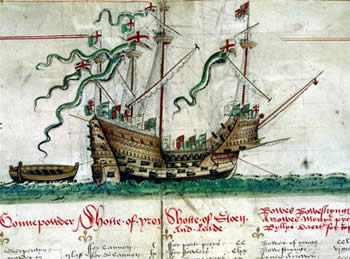
Time for another shipwreck story - scientists think they have solved the mystery of why the Mary Rose sank.
The Mary Rose was Henry VIII's finest warship, but she sank on 19 July 1545 while engaged in battle with the French Fleet, just off the southern coast of England. She took 415 men to their deaths, and Henry himself watched her disappear beneath the waves. But why did such a well-respected vessel sink so suddenly? The French navy claimed they had holed her, while the English said she tipped over while making a sharp turn, causing water to pour in through her open gun ports. Other theories have included everything from an unruly crew to an outbreak of dysentery.
Now researchers analysing the remains of some of the crew have come up with another idea - she sank because many of her crew were foreign, so language difficulties meant they were unable to understand orders in the heat of battle. Lynne Bell from the School of Criminology in Simon Fraser University in Burnaby, Canada, and her colleagues analysed oxygen isotope ratios in the bones and tooth enamel in 18 of the sunken sailors, and what they found was completely unexpected. Most naturally occurring oxygen exists as 16O, ie with 8 protons and 8 neutrons in the nucleus of each atom. But there are also tiny amounts of 18O, which has two extra neutrons. Water molecules containing 18O are heavier than normal, and condense more easily. So as moist air masses are carried away from the equator by prevailing winds, the heavier molecules are lost more easily as rain. The closer you get to the poles, the less 18O there is in the water. This ratio is carried over into the plants that grow in a region, and anything that eats those plants, so by looking at the ratio of 18O in someone's skeleton, you can tell where they spent most of their life.
Bell and her colleagues found that 30-60% of the sailors on the Mary Rose had 18O ratios too high for them to have been from England. They came from much further south, somewhere like Mediterranean Europe. In that case, their English probably wasn't great. As the Mary Rose turned, perhaps they weren't able to understand the order to close the gun ports in time to save her from sinking.
Those of you alert to archaeology news may have heard this before - a Channel 5 documentary mentioned it in the summer. But Bell's study is now being published, in next month's issue of Journal of Archaeological Science, so I thought it was worth mentioning again. Historians have uncovered documents refer to 600 Spanish mariners who had been stranded penniless at Falmouth 4 months earlier, and taken into the service of the King. Perhaps Henry, struggling to create Britain's first real navy in response to the French threat of invasion, was forced to use foreign crew on his prized warship - with tragic consequences.
Bell's detective work is about to hit the headlines again, by the way. She has also been studying the remains of a killer called the Mad Trapper who was caught and shot by the Mounties after a dramatic manhunt across the Canadian Arctic in 1932. This is where the expression "The Mounties always get their man" comes from. But who was he? Bell has carried out similar isotope tests on his exhumed body, to check his geographic origin and diet in the hope of establishing his true identity. The results are to be revealed in another documentary, apparently due to be shown on the Discovery Channel this month.